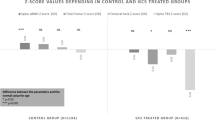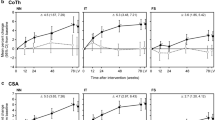Abstract
Chronic treatment with glucocorticoids (GCs) leads to significant bone loss and increased risk of fractures. In chronically GC-treated patients, hip fracture risk is nearly 50%. The purpose of this investigation was to determine if there are differences in the quantities of trabecular and cortical bone and bone strength of the hip between GC-treated osteoporotic patients and controls. Methods: Study subjects were GC-treated osteoporotic postmenopausal women, and controls were postmenopausal women, recruited for separate clinical trials. Quantitative computed tomography (QCT) and dual-energy X-ray absorptiometry (DXA) of the hip were obtained from all subjects. QCT outcome variables measured included total, cortical, and trabecular BMD of hip subregions (femoral neck and trochanter) and total hip. In addition, finite element modeling (FEM) was performed on a subset of 19 cases and 38 controls, matched on age (± 5 years), weight (± 5 kg), and history of hormone replacement (>1 year use) to assess failure load in stance and fall loading conditions. Generalized linear models were used to adjust the QCT variables for covariates between groups. Multiple regression was performed to identify independent predictors of bone strength from the QCT variables. Results: Compared with controls, GC-treated subjects were significantly (p<0.05) younger, weighed less, and had more years of hormone replacement. QCT of the hip in GC-treated subjects for total femoral integral, cortical, and trabecular BMD averaged 4.9–23.2% (p<0.002) less than controls, and similar results were seen by hip subregion including the trochanter and femoral neck. DXA of the total hip was 17% lower in GC subjects than controls (p<0.05). Compared with controls, FEM failure load in GC subjects was 15% (p<0.05) and 16% (p=0.07) lower for stance and fall loading conditions, respectively. Multiple regression analysis demonstrated that a combination of QCT measures was correlated with bone strength as measured by FEM. Conclusions: Chronic GC treatment in postmenopausal women resulted in significantly decreased BMD of the hip, measured by QCT, with loss of both trabecular and cortical bone. In addition, GC treatment decreased bone strength as determined by FEM. The reduced cortical and trabecular bone mass in the hip may contribute to the disproportionately high hip fracture rates observed in GC-treated subjects.

Similar content being viewed by others
References
Rehman Q, Lane NE (2003) Effect of glucocorticoids on bone density. Med Pediatr Oncol 41(3):212–216
Lane NE (2001) An update on glucocorticoid-induced osteoporosis. Rheum Dis Clin North Am 27(1):235–253
Van Staa TP, Leufkens HG, Cooper C (2002) The Epidemiology of corticosteroid-induced osteoporosis: a meta-analysis. Osteoporos Int 13:777–787
Van Staa TP, Leufkens HG, Abenhaim L, Zhang B, Cooper C (2000) Use of oral corticosteroids and risk of fractures. J Bone Miner Res 15(6):993–1000
Peel NF, Moore DJ, Barrington NA, Bax DE, Eastell R (1995) Risk of vertebral fracture and relationship to bone mineral density in glucocorticoid treated rheumatoid arthritis. Ann Rheum Dis 54:801–806
Van Staa TP, Laan RF, Barton IP, Cohen S, Reid DM, Cooper C (2003) Bone density threshold and other predictors of vertebral fracture in patients receiving oral glucocorticoid therapy. Arthitis Rheum 48(11):3224–3229
Cummings SR, Black DM, Nevitt MC, Browner W, Cauley J, Ensrud K et al and the Study of Osteoporotic Fractures Research Group (1993) Bone density at various sites for prediction of hip fractures. Lancet 341:72–75
Lafferty FW, Rowland DY (1996) Correlations of dual-energy X-ray absorptiometry, quantitative computed tomography, and single photon absorptiometry with spinal and non-spinal fractures. Osteoporos Int 6:407–415
Melton LJ 3rd, Atkinson EJ, O’Fallon WM, Wehner HW, Riggs BL (1993) Long-term fracture prediction by bone mineral assessed at different skeletal sites. J Bone Miner Res 8(10):1227–1233
Guglielmi G, Lang TF (2002) Quantitative computed tomography. Semin Musculoskelet Radiol 6(3):219–227
Genant HK, Gordon C, Jiang Y, Lang TF, Link TM, Majumdar S (1999) Advanced imaging of bone macro and micro structure. Bone 25(1):149–152
Lang TF, Augat P, Lane NE, Genant HK (1998) Trochanteric hip fracture: strong association with spinal trabecular bone mineral density measured with quantitative CT. Radiology 209(2):525–530
Rehman Q, Lang T, Modin G, Lane NE (2002) Quantitative computed tomography of the lumbar spine, not dual X-ray absorptiometry, is an independent predictor of prevalent vertebral fractures in postmenopausal women with osteopenia receiving long-term glucocorticoid and hormone-replacement therapy. Arthritis Rheum 46(5):1292–1297
Borah B, Gross GJ, Dufresne TE, Smith TS, Cockman MD, Chmielewski PA, Lundy MW, Jartke JR, Sod EW (2001) Three-dimensional microimaging (MRuI and uCT), finite element modeling, and rapid prototyping provide unique insights into bone architecture in osteoporosis. Anat Rec (New Anat) 265:101–110
Niebur GL, Feldstein MJ, Yuen JC, Chen TJ, Keaveny TM (2000) High-resolution finite element models with tissue strength asymmetry accurately predict failure of trabecular bone. J Biomech 33:1575–1583
Keyak J, Rossi SA, Jones KA, Les CM, HB Skinner (2001) Predicion of fracture location in the proximal femur using finite element models. Med Eng Phys 23:657–664
Keyak J (2003) Corrigendum to: “Improved prediction of proximal femoral fracture load using nonlinear finite element models” Med Eng Phys 23 (2001) 165–173. Med Eng Phys 25:615
Keyak J (2001) Improved prediction of proximal femoral fracture load using nonlinear finite element models. Med Eng Phys 23:165–173
LoCascio V, Bonucci E, Imbimbo B, Ballanti P, Adami S, Milani S, Tartarotti D, DellaRocca C (1990) Bone loss in response to long-term glucocorticoid therapy. Bone Miner 8(1):39–51
Lane NE, Sanchez S, Modin GW, Genant HK, Pierini E, Arnaud CD (1998) Parathyroid hormone treatment can reverse corticosteroid-induced osteoporosis. J Clin Invest 102(8):1627–1633
Lang TF, Keyak JH, Heitz MW, Augat P, Lu Y, Mathur A, Genant HK (1997) Volumetric quantitative computed tomography of the proximal femur: precision and relation to bone strength. Bone 21(1):101–108
Keyak JH, Rossi SA, Jones KA, Skinner HB (1998) Prediction of femoral fracture load using automated finite element modeling. J Biomech 31:125–133
Dempster DW, Arlot MA, Meunier PJ (1983) Mean wall thickness and formation periods of trabecular bone packets in corticosteroid-induced osteoporosis. Calcif Tissue Int 35:410–417
Dalle Carbonare L, Arlot ME, Chavassieux PM, Roux JP, Portrero NR, Meunier PJ (2001) Comparison of trabecular bone microarchitecture and remodeling in glucocorticoid-induced and postmenopausal osteoporosis. J Bone Miner Res 16:97–103
Manolagas SC, Weinstein RC (1999) New developments in the pathogenesis and treatment of steroid-induced osteoporosis. J Bone Miner Res 14:1061–1066
Sambrook P BJ, Kempler S, Kelly P, Eberl S, Pocock N, Yeates M, Eisman J (1990) Corticosteroid effects on proximal femur bone loss. J Bone Miner Res 5(12):1211–1216
Black DM, Greenspan SL, Ensrud KE, Palermo L, McGowan JA, Lang TF, Garnero P, Bouxsein ML, Bilezikian JP, Rosen CJ (2003) The effects of parathyroid hormone and alendronate alone or in combination in postmenopausal osteoporosis. N Engl J Med 349(13):1207–1215
Jiang Y, Zhao JJ, Mitlak BH, Wang O, Genant HK, Eriksen EF (2003) Recombinant human parathyroid hormone (1-34) [teriparatide] improves both cortical and cancellous bone structure. J Bone Miner Res 18(11):1932–1941
Cody DD, Hou FJ, Divine GW, Fyhrie DP (2000) Femoral structure and stiffness in patients with femoral neck fracture. J Orthop Res 18(3):443–448
Crawford RP, Cann CE, Keaveny TM (2003) Finite element models predict in vitro vertebral body compressive strength better than quantitative computed tomography. Bone 33:744–750
Leibschner MAK, Kopperdahl DL, Rosenberg WS, Keaveny TM (2003) Finite element modeling of the human thoracolumbar spine. Spine 28(6):559–565
Cody DD, Gross GJ, Hou FJ, Spencer HJ, Goldstein SA, Fyhrie DP (1999) Femoral strength is better predicted by finite element models than QCT and DXA. J Biomech 32:1013–1020
Cody DD, Hou FJ, Divine GW, Fyhrie DP (2000) Short term in vivo precision of proximal femoral finite element modeling. Ann Biomed Eng 28:408–414
Duboeuf F, Jergas M, Schott AM, Wu CY, Gluer CC, Genant HK (1995) A comparison of bone densitometry measurements of the central skeleton in post-menopausal women with and without vertebral fracture. Br J Radiol 68:747–753
Guglielmi G (1995) Quantitative computed tomography (QCT) and dual X-ray absorptiometry (DXA) in the diagnosis of osteoporosis. Eur J Radiol 20(3):185–187
Ito M, Lang TF, Jergas M, Ohki M, Takada M, Nakamura T, Hayashi K, Genant HK (1997) Spinal trabecular bone loss and fracture in American and Japanese women. Calcif Tissue Int 61(2):123–128
Lang TF, Guglielmi G, van Kuijk C, De Serio A, Cammisa M, Genant HK (2002) Measurement of bone mineral density at the spine and proximal femur by volumetric quantitative computed tomography and dual-energy X-ray absorptiometry in elderly women with and without vertebral fractures. Bone 30(1):247–250
Lang TF, Li J, Harris ST, Genant HK (1999) Assessment of vertebral bone mineral density using volumetric quantitative CT. J Comput Assist Tomogr 23(1):130–137
Yu W, Gluer CC, Grampp S, Jergas M, Fuerst T, Wu CY, Lu Y, Fan B, Genant HK (1995) Spinal bone mineral assessment in postmenopausal women: a comparison between dual X-ray absorptiometry and quantitative computed tomography. Osteoporos Int 5(6):433–439
Tsugeno H, Fujita T, Goto B, Sugishita T, Hosaki Y, Ashida K, Mitsunobu F, Tanizaki Y, Shiratori Y (2002) Vertebral fracture and cortical bone changes in corticosteroid-induced osteoporosis. Osteoporos Int 13:650–656
Author information
Authors and Affiliations
Corresponding author
Additional information
This work was supported by grants from the NIH 1R01AG05407, 1R01AR40431, 1R01AR46197, the Doris Duke Clinical Research Fellowship (CRF) Program for Medical Students (#20000684) K24AR048841-02 and the Rosalind Russell Arthritis Foundation.
Rights and permissions
About this article
Cite this article
Lian, KC., Lang, T.F., Keyak, J.H. et al. Differences in hip quantitative computed tomography (QCT) measurements of bone mineral density and bone strength between glucocorticoid-treated and glucocorticoid-naïve postmenopausal women. Osteoporos Int 16, 642–650 (2005). https://doi.org/10.1007/s00198-004-1736-9
Received:
Accepted:
Published:
Issue Date:
DOI: https://doi.org/10.1007/s00198-004-1736-9




